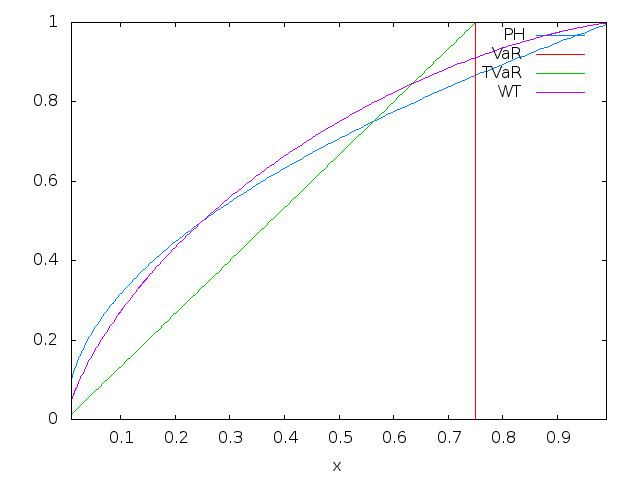 | ||
In the fields of actuarial science and financial economics there are a number of ways that risk can be defined; to clarify the concept theoreticians have described a number of properties that a risk measure might or might not have. A coherent risk measure is a function
Contents
- Properties
- Convex risk measures
- General framework of Wang transform
- Value at risk
- Average value at risk
- Entropic value at risk
- Tail value at risk
- Proportional Hazard PH risk measure
- g Entropic risk measures
- The Wang risk measure
- Entropic risk measure
- Superhedging price
- Set valued
- Set valued convex risk measure
- Dual representation
- References
Properties
Consider a random outcome
That is, the risk of holding no assets is zero.
That is, if portfolio
Indeed, the risk of two portfolios together cannot get any worse than adding the two risks separately: this is the diversification principle. In financial risk management, sub-additivity implies diversification is beneficial.
Loosely speaking, if you double your portfolio then you double your risk. In financial risk management, positive homogeneity implies the risk of a position is proportional to its size.
If
The portofolio
Convex risk measures
The notion of coherence has been subsequently relaxed. Indeed, the notions of Sub-additivity and Positive Homogeneity can be replaced by the notion of convexity:
General framework of Wang transform
A Wang transform of the cumulative distribution function is an increasing function
The dual distortion function is
For any increasing concave Wang transform function, we could define a corresponding premium principle :
A coherent risk measure could be defined by a Wang transform of the cumulative distribution function
Value at risk
It is well known that value at risk is not, in general, a coherent risk measure as it does not respect the sub-additivity property. An immediate consequence is that value at risk might discourage diversification. Value at risk is, however, coherent, under the assumption of elliptically distributed losses (e.g. normally distributed) when the portfolio value is a linear function of the asset prices. However, in this case the value at risk becomes equivalent to a mean-variance approach where the risk of a portfolio is measured by the variance of the portfolio's return.
The Wang transform function (distortion function) for the Value at Risk is
As a simple example to demonstrate the non-coherence of value-at-risk consider looking at the VaR of a portfolio at 95% confidence over the next year of two default-able zero coupon bonds that mature in 1 years time denominated in our numeraire currency.
Assume the following:
Under these conditions the 95% VaR for holding either of the bonds is 0 since the probability of default is less than 5%. However if we held a portfolio that consisted of 50% of each bond by value then the 95% VaR is 35% (= 0.5*0.7 + 0.5*0) since the probability of at least one of the bonds defaulting is 7.84% which exceeds 5%. This violates the sub-additivity property showing that VaR is not a coherent risk measure.
Average value at risk
The average value at risk (sometimes called expected shortfall or conditional value-at-risk) is a coherent risk measure, even though it is derived from Value at Risk which is not.
Entropic value at risk
The entropic value at risk is a coherent risk measure.
Tail value at risk
The tail value at risk (or tail conditional expectation) is a coherent risk measure only when the underlying distribution is continuous.
The Wang transform function (distortion function) for the tail value at risk is
Proportional Hazard (PH) risk measure
The PH risk measure (or Proportional Hazard Risk measure) transforms the hazard rates
The Wang transform function (distortion function) for the PH risk measure is
g-Entropic risk measures
g-entropic risk measures are a class of information-theoretic coherent risk measures that involve some important cases such as CVaR and EVaR.
The Wang risk measure
The Wang risk measure is define by the following Wang transform function (distortion function)
Entropic risk measure
The entropic risk measure is a convex risk measure which is not coherent. It is related to the exponential utility.
Superhedging price
The superhedging price is a coherent risk measure.
Set-valued
In a situation with
Properties
A set-valued coherent risk measure is a function
Set-valued convex risk measure
If instead of the sublinear property,R is convex, then R is a set-valued convex risk measure.
Dual representation
A lower semi-continuous convex risk measure
such that
A lower semi-continuous risk measure is coherent if and only if it can be represented as
such that
